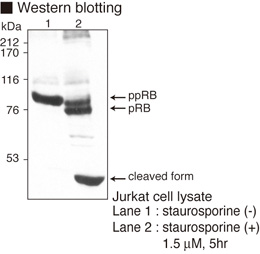Anti-Rb (Human) mAb
| Code | Size | Price |
|---|
| MBL-MK-15-3 | 100 ug | £323.00 |
Quantity:
Prices exclude any Taxes / VAT
Overview
Host Type: Mouse
Antibody Isotype: IgG2a κ
Antibody Clonality: Monoclonal
Antibody Clone: 3H9
Regulatory Status: RUO
Target Species: Human
Applications:
- Immunohistochemistry (IHC)
- Immunoprecipitation (IP)
- Western Blot (WB)
Shipping:
4°C
Storage:
-20°C
Images
Documents
Further Information
Applications:
WB - 5-10 ug/mL (chemiluminescence detection system) IP - 1-5 ug / 200-300 uL of cell extract IHC - 5 ug/mL (Heat treatment required for paraffin)
Background:
Mutation of the retinoblastoma tumor suppressor gene alone is sufficient to cause retinoblastoma in humans, suggesting that it might play a role in the normal coordination of cell proliferation and cell death. Deletion or mutational inactivation of the retinoblastoma tumor suppressor protein (Rb) is correlated with the genesis of a variety of human cancers including retinoblastoma, osteosarcoma, and carcinomas of the breast, bladder, and lung. Rb protein is phosphorylated by cyclinD-Cdk4/Cdk6 and cyclinA/cyclinE-Cdk2 during the G1/S transition. This phosphorylation causes the inactivation of the growth inhibitory functions of Rb. Rb undergoes phosphorylation and functional inactivation, permitting the cell to proceed into late G1.
Concentration:
1 mg/mL
Formulation:
100 ug IgG in 100 ul PBS containing 50% glycerol, pH 7.2. Contains no preservatives.
Gene IDs:
Human: 5925 Mouse: 19645
Immunogen Translated:
Recombinant human Rb (612-928 a.a.)
Reactivity:
This antibody reacts with human
retinoblastoma gene product (110-115 kDa).
Shelf Life:
1 year
Source:
This antibody is precipitated from hybridoma
(clone 3H9) supernatant using protein A Sepharose. This
hybridoma was established by fusion of mouse myeloma
cell P3U1 with Balb/c mouse splenocyte immunized with
the recombinant human Rb protein corresponding to amino
acids 612-928.
Target:
Rb
References
1) Lalande, M., et al. Cancer Genet.Cytogenet. 13,
283-295 (1984)
2) Lee, W. H., et al. Science, 235, 1394-1399 (1987)
3) Taya, Y., et al. Biochem. Biophys. Res. Commun. 164,
580-586 (1989)
4) Lin, B. T. Y., et al. EMBO J. 10, 857-864 (1991)
5) Wang, N.P., et al. Cell Growth Differ. 1, 233-239 (1990)



